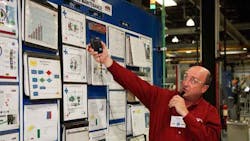"Zero is a beautiful number," says Todd Seeley, director of operations and plant manager at Case New Holland's Wichita, Kan., manufacturing plant.
It is the number of quality losses his facility and its people aspire to, the number of accidents they like to see, and the number of problems they want to occur. Seeley describes it as the Zero Optimum Concept.
"Our goal is not to be 20% better or 50% better," he says, "We want a zero-problem" site.
World Class Manufacturing (WCM) is how the manufacturer aims to get there, explains Humberto Del Rio, continuous improvement manager at the facility, which is located on an 80-acre site not far from the Wichita Mid-Continent Airport. It is the sole manufacturing plant for CNH's skid steer loaders, and employs 472 plant employees (639 overall).
Recently it was the site of an IndustryWeek Excellence in Action plant tour.
Like the Toyota Production System, WCM is a system for continuous improvement. The two methodologies share many similar tools and concepts, including just-in-time, autonomous maintenance, yamazumi boards (used to balance processes), the 5 Whys problem-solving technique and extensive employee involvement to drive improvements.
The Wichita plant's introduction to WCM is by way of Fiat Industrial, of which Case New Holland (IW 1000/259) is a majority-owned subsidiary.
Unlike Toyota, WCM's approach to improvement is built on a structure of 10 technical pillars, including logistics, people development and early equipment management, among others. Another component of World Class Manufacturing is semi-annual external audits to measure improvement against WCM standards. Indeed, Seeley serves as an auditor at other sites implementing World Class Manufacturing.
Losses Drive Priorities
For the similarities one can find between the Toyota Production System and WCM, Seeley outlines what he sees as a key difference between the two systems. He says unlike the Toyota Production System, WCM provides a structure that guides where to focus improvement efforts. Losses drive the priority of improvement projects, specifically losses in the areas of safety, cost and quality. The bigger the loss, translated to dollars, the higher the priority.
"Toyota just says, 'go fix.' It doesn't prioritize" what to fix, Seeley says. "World Class Manufacturing identifies a place to start."
Several years into its WCM efforts, Case New Holland's facility can outline multiple improvements it has accomplished on its road to zero. For example, the plant has increased throughput in its highly automated weld shop by approximately 30%. Continuous-improvement activities such as minimum material handling, autonomous maintenance, just-in-time methods and bottleneck reduction contributed to the gains, Del Rio says.
Minimal material concepts also rule in assembly, where fully automated tuggers move parts, improve ergonomics and relieve employees for more value-added activities.
In fact, over the period of one year, improvement activities by Wichita employees reduced assembly line takt time from 12 minutes to 10.5 minutes, with Del Rio also giving kudos to simulation software in helping to drive the gain. And while the takt-time improvement may not seem huge in isolation, given the amount of product the facility produces, it adds up -- and also helps to cut down on overtime hours, Del Rio notes.
Outlining additional improvements, the continuous-improvement manager notes that a single flexible assembly line produces both the Case and New Holland product brands. Previously each brand had a dedicated assembly line.
The drive to zero continues. "[World Class Manufacturing] is a never-ending journey," Del Rio says.
About the Author
Jill Jusko
Bio: Jill Jusko is executive editor for IndustryWeek. She has been writing about manufacturing operations leadership for more than 20 years. Her coverage spotlights companies that are in pursuit of world-class results in quality, productivity, cost and other benchmarks by implementing the latest continuous improvement and lean/Six-Sigma strategies. Jill also coordinates IndustryWeek’s Best Plants Awards Program, which annually salutes the leading manufacturing facilities in North America.
Have a story idea? Send it to [email protected].

